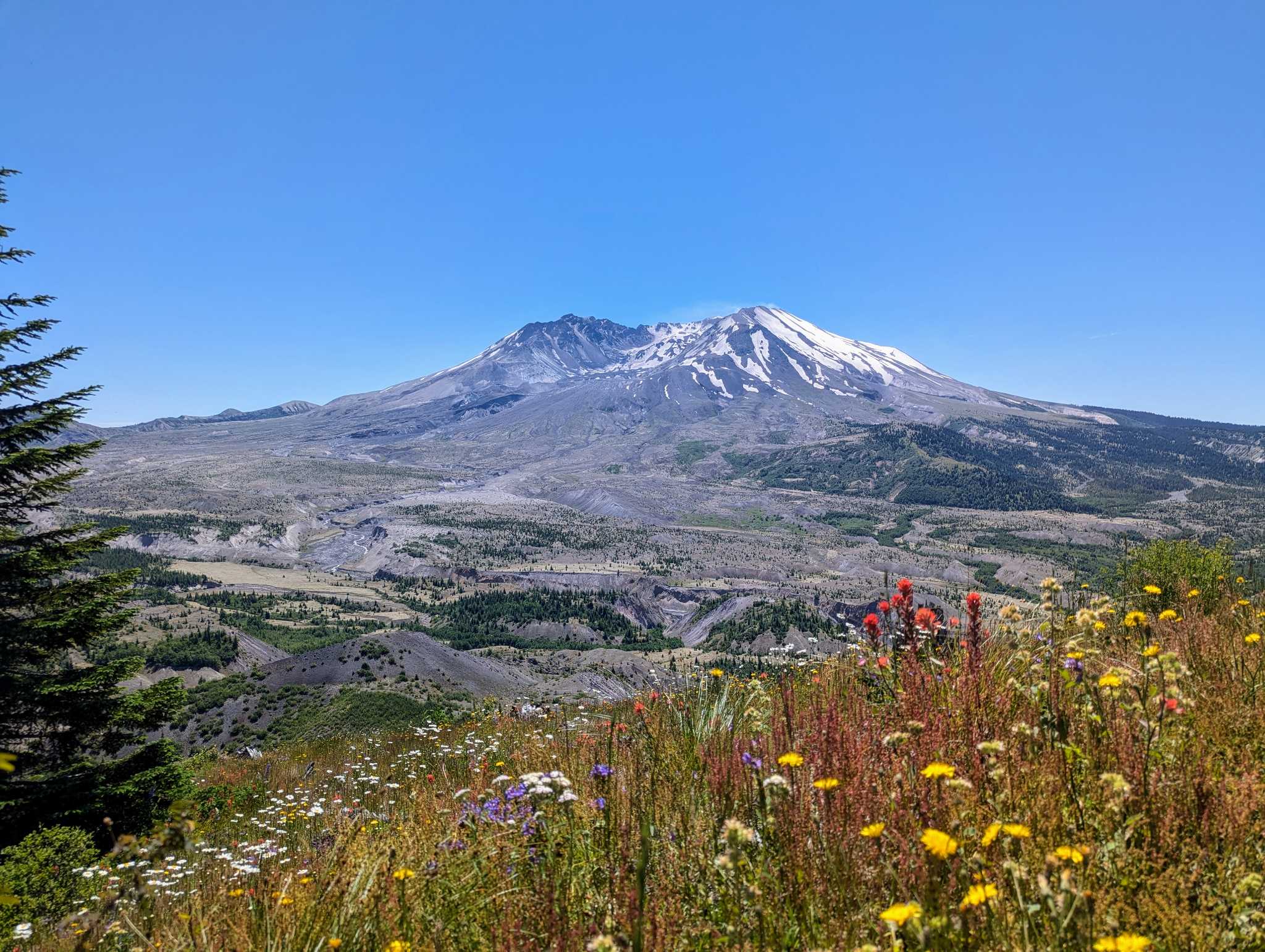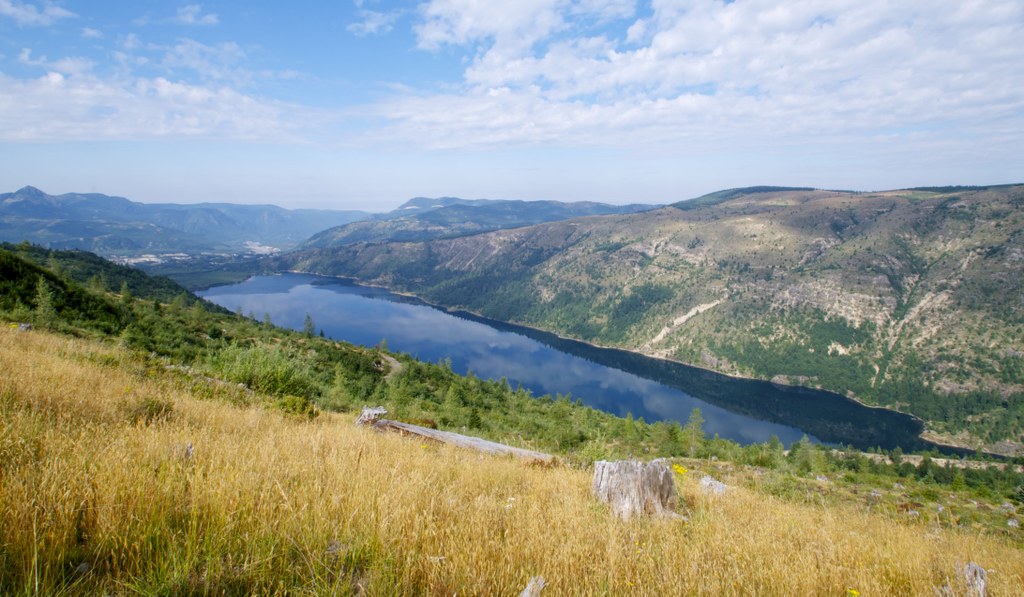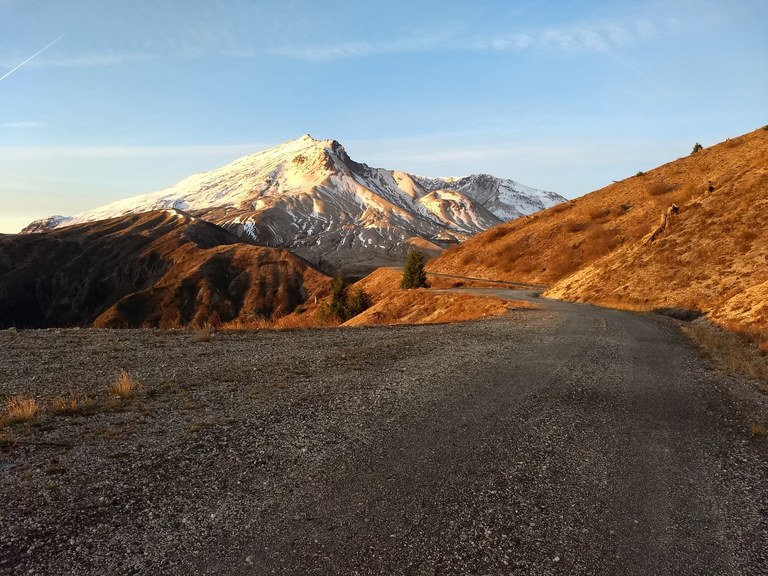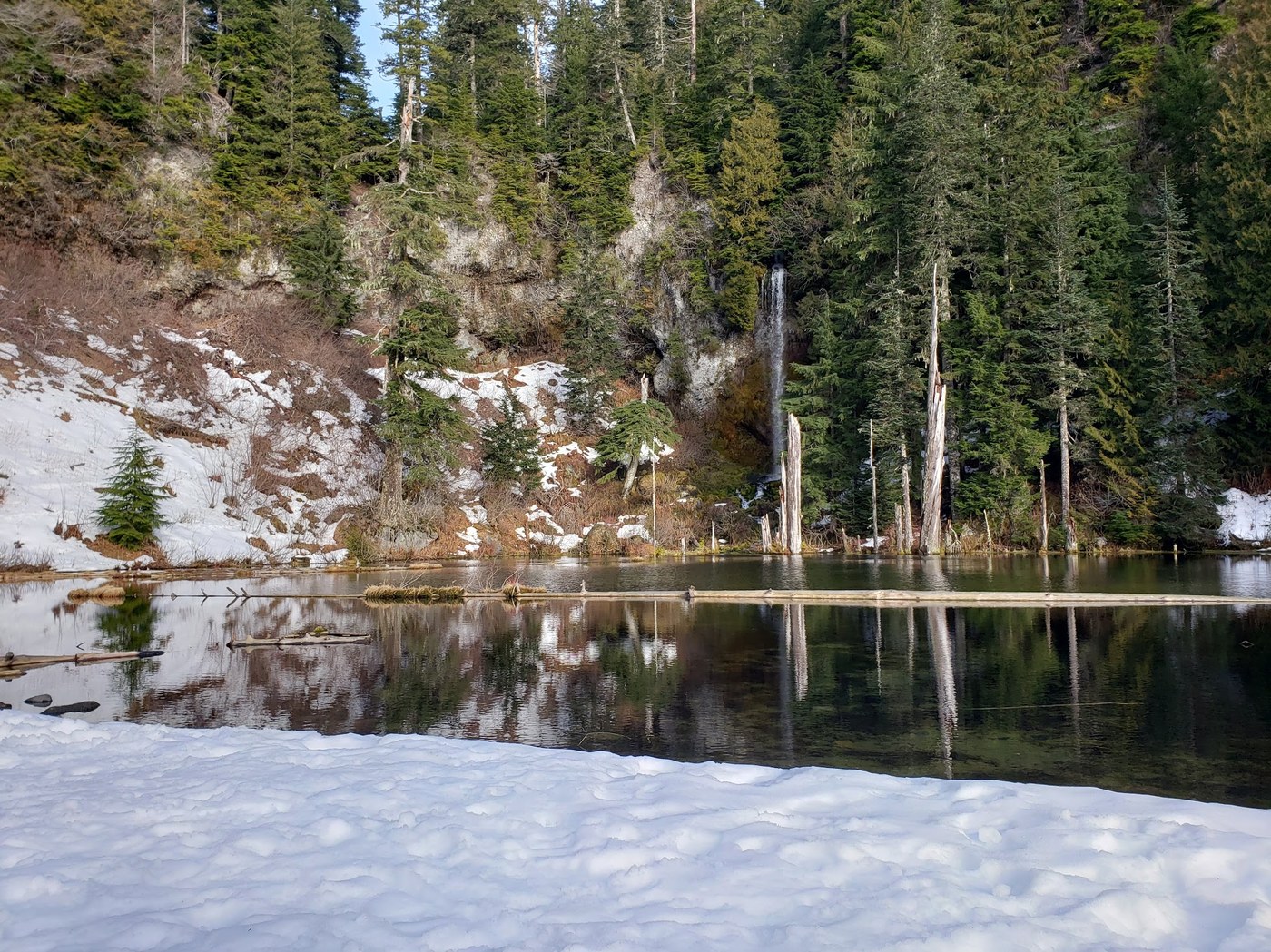Mount St. Helens Hikes
In 1980, when Mount St. Helens famously erupted, no one could have dreamed of the magical hiking destination it would become. Over 200 miles of trails allow access to a fascinating landscape marked by gorgeous summer wildflowers, young forests, new lakes, huge mounds of ash and rock and a growing volcanic crater rimmed by the state's newest glacier.

Boundary Trail. Photo by trip reporter Christa Linn.
Mount St. Helens National Monument offers short hikes and excellent visitor centers for families, moderate hikes with grand views for day hikers and extremely difficult terrain — with true solitude — for backcountry enthusiasts. Each of the three access points is a gateway to a different experience, and even long-time visitors will find something new in the hikes featured below.
Summer of 2025: What you need to know
Mount St. Helens is also in a dynamic landscape, and that means access can be difficult. If you’re planning to visit in the summer of 2025, there are some road closures and construction that you should know about. Also, keep in mind that high-elevation areas tend to melt out slowly. So check trip reports and road conditions before heading out. And remember that snow melts out late at the higher elevations around Mount St. Helens. Here's some information about access to trails and trailheads in the area.
Johnston Ridge Observatory/Visitor Center and SR 504
State Route 504, which provides access to the west side of the mountain, is closed due to a landslide past Coldwater Lake. This means that the Johnston Ridge Observatory is inaccessible and closed. Hikes near the observatory are also inaccessible from SR 504.
Windy Ridge, Forest Road 25 and Forest Road 99
A number of issues affect access to this area, which provides access to the north and east side of the mountain, including Windy Ridge and the surrounding trails.
- A washout on Forest Road 25 means that this area of the park (including Windy Ridge) is not accessible from the south. Due to that washout, FR 25 is closed between Elk Pass (at the north end) and Clearwater Viewpoint (at the south end). Access to this area of the monument is from Randle on Highway 12.
- The Huffaker Bridge, where FR 25 crosses the Cispus River, will be closed until November. With that closure, the only way to get to Iron Creek Campground and FR 99, which provides access to Windy Ridge, is to travel south on FR 23, then take FR 28 to FR 76. Then, travel west on FR 76. Note that FR 76 is a single-lane road with turnouts. It has potholes and must be driven at low speeds. Also be aware that there will be logging traffic on FR 76.
- Work is being done in the Windy Ridge area, near Spirit Lake, to improve the outlet from Spirit Lake. Trails in the area will be closed from Monday through Friday, but open on federal holidays and weekends, through Oct. 31. Part of the Windy Ridge parking area will also be closed for a contractor staging area and the lower trailhead will also be closed for contractor parking, meaning that when the trails are open, hikers will need to walk that section of road to get to trailheads. These trails are affected by the Monday–Friday closure: Truman Trail, Plains of Abraham trail, Windy Trail and Harry’s Ridge.
Tips for hiking at Mount St. Helens
- Permits — Interagency or Northwest Forest Pass: Many trailheads in and around the Mount St. Helens National Volcanic Monument require a Northwest Forest Pass or Interagency pass. If you do not have a pass, in some area you can scan and pay using the Recreation.gov app. Download it in advance, while you still have cell service.
- The Coldwater Science and Learning Center will open for the season on May 17. It's open daily from 10 a.m. to 4 p.m. through October. If you don't have a parking pass, you will need to use the scan and pay option.
-
The Johnston Ridge Observatory/Visitor Center is closed due to a landslide on SR 504.
- Be prepared for the elements! With little tree cover, hikers are exposed to the sun, the rain and especially the wind. Bring a hat, sunscreen, sunglasses and layers to adjust to the changing conditions.
- Carry lots of water. Water is scarce along many of the trails, so it is important to bring plenty of it with you.
- Leave your pups at home. Due to the sensitive ecosystem, dogs are not allowed in many areas of the park.
From the west
The west side of the Mount St. Helens National Monument was transformed by the 1980 eruption. Old-growth forest gave way in an instant to the explosion and subsequent lahar and mudflow. A new lake was formed. Today, this area is one of the most popular entrances to the Monument, and it's easy to see why. Almost every mile of trail offers excellent views into the mouth of the crater and profuse wildflowers line the pumice plains and ridges.
Hummocks Trail
Location: Spirit Lake Highway
Mileage: 2.3 miles, roundtrip
Elevation gain: 100 feet

Hummocks Trail. Photo by trip reporter Lebunnyman.
Thirty years ago, this was an old-growth forest. Not anymore! While life has certainly returned to this valley, the landscape is now defined by towering mounds of ash, rock and mud.
This is a great trail to gain an appreciation of the devastating effects of the eruption of Mount St. Helens and to marvel at the vitality of nature's return. The loop trail takes you by small ponds, the North Fork Toutle River and hummock mounds up to 500 feet high.
> Plan your trip to Hummocks Trail using WTA's Hiking Guide
Lakes Trail
Location: Spirit Lake Highway
Mileage: 8 miles, roundtrip
Elevation gain: 500 feet

Lakes Trail. Photo by trip reporter Niko Niko.
Believe it or not, Coldwater Lake didn't even exist before the 1980 eruption. The ancient forest that once towered here was blown away and dammed up Coldwater Creek. Now, a large and beautiful lake tempts visitors with fabulous hiking on both sides. This is also a great trail from which to view wildflowers and wildlife, especially elk.
> Plan your trip to Lakes Trail using WTA's Hiking Guide
South Coldwater Trail
Location: Spirit Lake Highway
Mileage: 7 miles, roundtrip
Elevation gain: 1,400 feet

South Coldwater Trail. Photo by Steven Payne.
This lovely early or late-season hike takes you for a ridge walk high above Coldwater Lake. You'll walk through a serene willow forest, marvel at the power of nature when you encounter twisted hulks of logging machinery, and see plenty of gnarled stumps where tall evergreens once stood.
> Plan your trip to South Coldwater Trail using WTA's Hiking Guide
From the east
Trails accessed from the northeast offer a variety of habitat. Some areas were beyond reach of the blast and today enjoy the cool shade of ancient forests. Closer to Windy Ridge the topography changes considerably from ghostly Spirit Lake with silver logs still floating in its waters, to old trees all blown down in the same direction, and lots and lots of wind. This is the edge of the blast zone.
Note: These trails are affected by the detour on FR 25 due to the Huffaker Bridge closure. See details at top for more information.
Meta Lake
Location: Randle area
Mileage: 1.3 miles, roundtrip
Elevation gain: 500 feet

Meta Lake. Photo by trip reporter ejain.
The trail to Meta Lake is short, sweet and paved — offering a barrier-free hike that is accessible for people in wheelchairs. Despite being in the blast zone, this area is defined by a young forest. These trees survived the eruption by being under a thick blanket of snow. The quiet lake is a fun destination for kids, especially in mid-summer when they can look for tadpoles and trout in its clear waters.
> Plan your trip to Meta Lake using WTA's Hiking Guide
Norway Pass - Mount Margaret
Location: Randle area
Mileage: 4.4 miles, roundtrip to Norway Pass; 11 miles, roundtrip to Mount Margaret
Elevation gain: 860 feet to Norway Pass; 1,500 feet to Mount Margaret

View of Mount St. Helens from Norway Pass. Photo by terradactyl.
From the get-go, the short hike to Norway Pass is spectacular—witness the matchbook-blown forest, the incredible views to Rainier, Adams and Hood, and finally Mount St. Helens herself with ghostly Spirit Lake in the foreground. All of this while traipsing through beautiful wildflower fields along a windy ridge.
> Plan your trip to Norway Pass - Mount Margaret using WTA's Hiking Guide
Plains of Abraham - Windy ridge loop
Location: Windy Ridge Viewpoint
Mileage: 8 miles, roundtrip
Elevation gain: 2,000 feet

Wildflowers along the trail. Photo by trip reporter Zachary1992.
It doesn't take long to get wide-open views on this trail. Rainier and Adams are on full display as you climb a ridge with drop-offs on either side. After this breathtaking section, drop down and see the flowers that are on display in the Plains of Abraham.
Note: This trail is only open on the weekends and federal holidays. See details at top for more information.
> Plan your trip to Plains of Abraham - Windy Ridge Loop using WTA's Hiking Guide
Truman Trail - Pumice Plains
Location: Randle Area
Mileage: 10 miles, roundtrip
Elevation Gain: 200 feet

Truman Trail - Pumice Plains. Photo by lonerwolf.
This area was filled with 600 feet of mud from the landslide triggered by the Mount St. Helens eruption. Today, birds and wildlife abound on the plains. The trail descends directly into the blast zone, and continues by the crater. Rock, ash, and mud dominate the terrain for two miles until reaching the Pumice Plains by Spirit Lake. Alongside the lake, take in views of the volcano and the region impacted by the eruption.
Note: This trail is only open on the weekends and federal holidays. See details at top for more information.
> Plan your trip to Truman Trail - Pumice Plains using WTA's Hiking Guide
From the north
Visiting Mount St. Helens from the north is a more remote experience. Many of these trails start outside the blast zone, and hikers have to work their way in, appreciating the stark change in scenery that much more. Views of the mountain in the distance and longer approaches make for a rewarding exploration of a different side to this iconic volcano.
Goat Mountain and Deadman's Lake
Location: Randle Area
Mileage: 11.2 miles, roundtrip
Elevation gain: 2,400 feet

Goat Mountain and Deadman's Lake. Photo by gspdodger.
Begin this hike outside the blast zone and work your way to that boundary. Starting out with a steep climb, this trail crests a ridge that stretches out for the remainder of the hike. Stay high and take in views of Mount Rainier and Mount Adams, or drop down to Deadman's Lake.
Note: This trail is affected by the detour on FR 25 due to the Huffaker Bridge closure. See details at top for more information.
> Plan your trip to Goat Mountain and Deadman's Lake using WTA's Hiking Guide
Goat Creek Loop
Location: Morton Area
Mileage: 20.2 miles, roundtrip
Elevation gain: 3,200 feet

Goat Creek Loop. Photo by trip reporter johnco.
This backpacking loop will take you through the northern reaches of Mount St. Helens. It works well as a two-day trip, with a challenging first day and a leisurely second. Start outside the blast zone, circling through it as you pass lakes, waterfalls and mossy creeks. This is also the approach for Vanson Peak.
> Plan your trip to Goat Creek using WTA's Hiking Guide
Green River
Location: Randle Area
Mileage: 11.6 miles, roundtrip
Elevation gain: 940 feet

Green River. Photo by trip reporter MeatMan.
This trail will plunge hikers into the shady forest above the Green River. Enjoy the display of water as you hop across creeks and marvel at twinkling waterfalls. Those who keep going will be rewarded with a grove of old growth that survived the 1980 eruption. Take your time walking under these giants.
Note: This trail is affected by the detour on FR 25 due to the Huffaker Bridge closure. See details at top for more information.
> Plan your trip to Green River using WTA's Hiking Guide
From the south
The south side of Mount St. Helens was left almost untouched by the events of May 18, 1980, but has been sculpted by other lava flows over the centuries. Hikers here will get a completely different experience with caves, canyons, forests and access to the crater rim.
June Lake
Location: Outside the town of Cougar
Mileage: 2.86 miles, roundtrip
Elevation Gain: 445 feet

June Lake in the winter. Photo by trip reporter Shaniah.
June Lake is a great option for families or those looking for the shortest access to the Loowit trail, which circumnavigates St. Helens. In any case, it's a gem where you can rest while watching a waterfall on the distant shore of the lake. Note that the parking lot at June Lake is day-use only, and backpackers on the Loowit trail will need to start elsewhere along the loop.
> Plan your trip to June Lake using WTA's Hiking Guide
Lava Canyon
The suspension bridge on the Lava Canyon trail is currently closed due to cable damage, rendering the 1.4-mile upper loop of the trail unreachable.
Location: Outside the town of Cougar
Mileage: 5 miles roundtrip
Elevation gain: 1,600 feet

Suspension bridge on the Lava Canyon Trail. Photo by trip reporter TravelerTed.
If you’re a thrill seeker, look no further than Lava Canyon. Starting on a paved interpretive trail, this route crosses a springy suspension bridge before plunging into the Lava Canyon Gorge. At the bottom of the gorge (a descent which includes climbing down a 30-foot ladder), the trail winds along a steep and narrow section, passing “The Ship” spur trail, which leads to scenic views of nearby waterfalls. On top of being an exhilarating trip, the trail offers a unique perspective on the power of volcanic eruptions: The gorge was filled by sediment until it was scoured clean by lahar flows during the 1980 eruption.
> Plan your trip to Lava Canyon using WTA's Hiking Guide
Butte Camp
Location: Outside the town of Cougar
Mileage: 5 miles, roundtrip
Elevation gain: 700 feet

Butte Camp Photo by trip reporter akzander06.
For those looking for an easy outing or short overnight, Butte Camp offers impressive bang for your buck. In only 2.5 miles, the trail passes through stately native forests and dramatic lava beds and fields of wildflowers with grand views of Mount St. Helens. Use Butte Camp as a turnaround point, or make camp and explore the Loowit Trail, which is just another mile up Butte Camp Dome. Permits are not needed here!
> Plan your trip to Butte Camp using WTA's Hiking Guide
Climbing Mount St. Helens
Monitor Ridge
Location: Outside the town of Cougar
Mileage: 10 miles, roundtrip
Elevation gain: 4,500 feet

Trail up Monitor Ridge. Photo by trip reporter Strider.
Make no mistake. Climbing to the summit of Mount St. Helens is exhausting business. But the happy news for non-climbers is that you can reach the top without technical skills, making this singular experience within reach for hearty hikers willing to endure several miles of boulder fields and ash climbing. It's amazing and awe-inspiring to stand on the rim of this not-so-quiet volcano and watch geology in the making.
Permits are required to climb to the summit and are available online from the Mount St. Helens Institute after March 1, released in one-month increments on the first day of the previous month. Plan early if you wish to climb the volcano during the peak season or on weekends.
> Plan your trip to the Monitor Ridge route using WTA's Hiking Guide
Worm Flows Route
Location: Outside the town of Cougar
Mileage: 12 miles, roundtrip
Elevation gain: 5,699 feet

Worm Flows Route. Photo by trip reporter TheDirtBaguette.
This is the go-to route to the summit when Mount St. Helens is covered in snow. It is direct, but that doesn't mean it's easy. Long miles of snow travel can be grueling, but luckily, this route is not too technical. It is considered a good intro to mountaineering, and the views at the top are stunning.
> Plan your trip to the Worm Flows route using WTA's Hiking Guide
Long trails around the mountain
Loowit Trail
Location: Windy Ridge
Mileage: 32 miles, roundtrip
Elevation gain: 6,000 feet

Views from Castle Ridge. Photo by Britt Le.
The Loowit trail circumnavigates Mount St. Helens in around 32 miles. To be sure, this is a challenging route because the trail climbs in and out of the many gullies that form the flanks of this mountain. Conditions are shifting in these environments, so some route finding is necessary. No other trail will give you such a comprehensive look at this iconic mountain.
Note: Sections of this trail near Windy Ridge are affected by the Monday-Friday closures. See note at top.
> Plan your trip to Loowit Trail using WTA's Hiking Guide
Boundary Trail
Location: Various
Mileage: 57 miles, roundtrip
Elevation gain: 12,300 feet

View from Norway Pass along the Boundary Trail. Photo by trip reporter Lebunnyman.
The Boundary Trail runs generally east-west through the varied landscapes on the north side of Mount St. Helens. It is a route that connects multiple trail segments, and offers access to countless junctions, detours and loop options.

